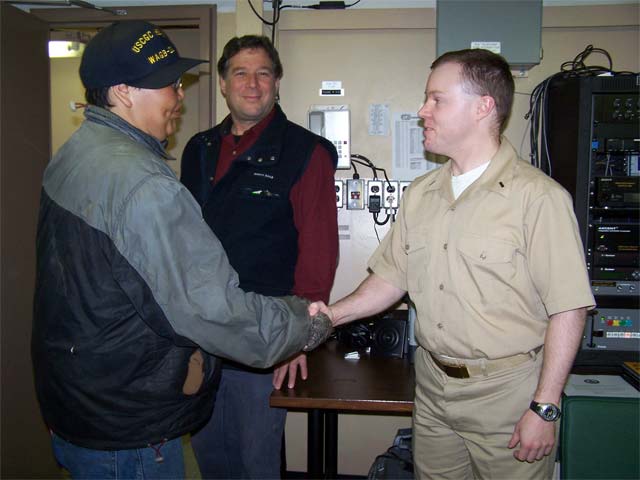( Log In ) Log In is for TREC Teachers & Researchers only
  |
| Patricia_Janes |
 Jun 2 2006, 08:51 PM Jun 2 2006, 08:51 PM
Post
#1
|
 Advanced Member    Group: TREC Team Posts: 96 Joined: 12-April 06 Member No.: 24 |
May 30, 2006 – Aboard the Healy
Longitude: 171.991081 W, Latitude: 63.508440 N In my journal entry from May 14, 2006 (Part II), I introduced you to Bobby Ungwiluk, an eleventh grader from Gambell. When I visited Gambell earlier in the expedition, Bobby showed me around. To refresh your memory a little more: Bobby won first place in the Bering Strait School District’s science fair. He also won six awards at Alaska’s statewide science fair, including NOAA’s prestigious “2005-2006 Taking the Pulse of the Planet Award.” His project examined the effects that climate change and reduced sea ice would have on native Alaskan subsistence hunters and their way of life. At the end of that journal entry, I expressed the hope that one day I might be able to show Bobby and his science teacher, Bob Woolf, around my hometown. Today, the next best thing happened: Bobby, his teacher, and Edmond Apassingok, the President of the IRA Council (the local tribal government) in Gambell, came aboard the Healy for a few hours to tour the ship and learn more about the science taking place onboard. Sam and I joined the scientists in the helicopter hangar to greet the trio. This was Bobby’s first helicopter trip and his first time aboard an icebreaker, so it was all very new to him. We took our visitors down to the mess deck for lunch, and then showed them the science lab spaces. We were between science stations, so the lab was pretty quiet. Scientists Lee and Jim explained the CTD, van Veen grab, HAPS core, and trawl net to Bobby, Bob, and Edmond. Being that Gambell is made up of subsistence hunters, they were very interested in hearing about how these instruments are measuring the changes in the Bering Sea ecosystem. Any change in the community of animals living at the seafloor could also affect the numbers and health of the walruses and seals that the hunters rely on for food.  Bob, Bobby, Lee, and Jim discuss changes that are taking place in the Bering Sea. Edmond talked with me about the changes in ice cover that he has seen over the years. According to him, the ice is much thinner now than it has been in recent decades. That can be dangerous for hunters, he said, because often they get out of their boats to prepare the animals before bringing them home. If the ice is too thin, then it can’t safely support the weight of the hunters.  Edmond Apassingok scans the ice from the Healy’s uppermost deck. As a subsistence hunter that relies on thick sea ice, he has seen firsthand the effects of climate change. While onboard the Healy, Bobby had a chance to meet LTjg Wagonseller, from NOAA. That was an exciting moment, since Bobby had won a NOAA award for his science fair project.  LTjg Wagonseller of NOAA congratulates Bobby Ungwiluk on a job well done. Bobby won NOAA’s 2005-2006 Taking the Pulse of the Planet Award for his science fair project. After touring the rest of the ship and talking with a few more scientists, it was time for our visitors to return home. We went back to the hangar and said our goodbyes. Then, I joined Lee and Jim in the helicopter command center to wave farewell as the helo zipped off across the sea.  Bobby, Bob, and Edmond listen intently to the helicopter safety guidelines before boarding the helo bound for Gambell on St. Lawrence Island.  After a two hour tour of the Healy, Bobby, Bob, and Edmond flew back to Gambell. |
  |
1 User(s) are reading this topic (1 Guests and 0 Anonymous Users)
0 Members:

|
NSF Acknowledgment & Disclaimer | Time is now: 8th November 2024 - 05:36 AM |
Invision Power Board
v2.1.7 © 2024 IPS, Inc.








